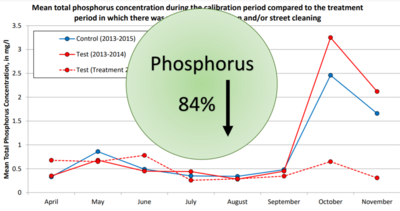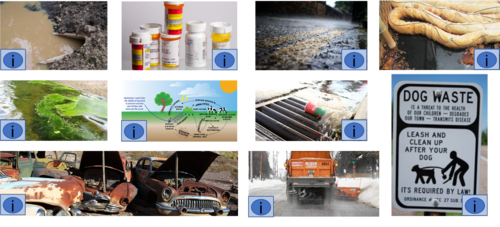
Difference between revisions of "Minnesota Stormwater Manual test page 5"
m () |
m () |
||
| Line 5: | Line 5: | ||
Image:Pollutants image map.png|500px|thumb|alt=imagemap for stormwater BMPs|'''Pollutants in stormwater runoff'''. Mouse hover over an '''i''' box to read a description of the pollutant, or click on an '''i''' box to go to a page on the pollutant. | Image:Pollutants image map.png|500px|thumb|alt=imagemap for stormwater BMPs|'''Pollutants in stormwater runoff'''. Mouse hover over an '''i''' box to read a description of the pollutant, or click on an '''i''' box to go to a page on the pollutant. | ||
circle 100 500 30 [[Total Suspended Solids (TSS)|Total suspended solids, or sediment, originate from many sources including the erosion of pervious surfaces and dust, litter and other particles deposited on impervious surfaces from human activities and the atmosphere. Erosion at construction sites are also major sources of solids. Solids contribute to many water quality, habitat and aesthetic problems in urban waterways. Elevated levels of solids increase turbidity, reduce the penetration of light at depth within the water column, and limit the growth of desirable aquatic plants. Solids that settle out as bottom deposits contribute to sedimentation and can alter and eventually destroy habitat for fish and bottom-dwelling organisms. Solids also provide a medium for the accumulation, transport and storage of other pollutants including nutrients and metals.]] | circle 100 500 30 [[Total Suspended Solids (TSS)|Total suspended solids, or sediment, originate from many sources including the erosion of pervious surfaces and dust, litter and other particles deposited on impervious surfaces from human activities and the atmosphere. Erosion at construction sites are also major sources of solids. Solids contribute to many water quality, habitat and aesthetic problems in urban waterways. Elevated levels of solids increase turbidity, reduce the penetration of light at depth within the water column, and limit the growth of desirable aquatic plants. Solids that settle out as bottom deposits contribute to sedimentation and can alter and eventually destroy habitat for fish and bottom-dwelling organisms. Solids also provide a medium for the accumulation, transport and storage of other pollutants including nutrients and metals.]] | ||
| − | circle | + | circle 1700 500 30 [[Chemicals of emerging concern in stormwater|Chemicals of emerging concern]] |
| − | circle | + | circle 2800 500 30 [[Temperature in stormwater|Temperature]] |
circle 690 150 30 [[Organics in stormwater|Permeable pavements allow stormwater runoff to filter through surface voids into an underlying stone reservoir for temporary storage and/or infiltration. The most commonly used permeable pavement surfaces are pervious concrete, porous asphalt, and permeable interlocking concrete pavers (PICP). Permeable pavements have been used for areas with light traffic at commercial and residential sites to replace traditional impervious surfaces in low-speed roads, alleys, parking lots, driveways, sidewalks, plazas, and patios.]] | circle 690 150 30 [[Organics in stormwater|Permeable pavements allow stormwater runoff to filter through surface voids into an underlying stone reservoir for temporary storage and/or infiltration. The most commonly used permeable pavement surfaces are pervious concrete, porous asphalt, and permeable interlocking concrete pavers (PICP). Permeable pavements have been used for areas with light traffic at commercial and residential sites to replace traditional impervious surfaces in low-speed roads, alleys, parking lots, driveways, sidewalks, plazas, and patios.]] | ||
circle 30 325 30 [[Phosphorus|Dry swales, sometimes called grass swales, are similar to bioretention cells but are configured as shallow, linear channels. They typically have vegetative cover such as turf or native perennial grasses. Dry swales may be constructed as filtration or infiltration practices, depending on soils. If soils are highly permeable (A or B soils), runoff infiltrates into underlying soils. In less permeable soils, runoff is treated by engineered soil media and flows into an underdrain, which conveys treated runoff back to the conveyance system further downstream. Check dams incorporated into the swale design allow water to pool up and infiltrate into the underlying soil or engineered media, thus increasing the volume of water treated.]] | circle 30 325 30 [[Phosphorus|Dry swales, sometimes called grass swales, are similar to bioretention cells but are configured as shallow, linear channels. They typically have vegetative cover such as turf or native perennial grasses. Dry swales may be constructed as filtration or infiltration practices, depending on soils. If soils are highly permeable (A or B soils), runoff infiltrates into underlying soils. In less permeable soils, runoff is treated by engineered soil media and flows into an underdrain, which conveys treated runoff back to the conveyance system further downstream. Check dams incorporated into the swale design allow water to pool up and infiltrate into the underlying soil or engineered media, thus increasing the volume of water treated.]] | ||
Revision as of 20:21, 12 July 2022
Warning: This page is an edit and testing page use by the wiki authors. It is not a content page for the Manual. Information on this page may not be accurate and should not be used as guidance in managing stormwater.
Information
Reporting phosphorus and TSS reduction credits from street sweeping

Research conducted by Bill Selbig (USGS) shows that streets, when cleaned of leaf litter prior to a storm, can significantly decrease phosphorus loads in stormwater runoff (Link to study)
At this time, the MPCA has not developed guidance for how to credit reductions in phosphorus or total suspended solid loading associated with enhanced street sweeping. We anticipate developing this guidance in 2022. In developing this guidance, consider the following.
- Baseline: Credits toward permit compliance, such as compliance with total maximum daily loads, can only be applied toward enhanced street sweeping. This is sweeping that results in pollutant reductions above pollutant reductions associated with sweeping that occurred at the baseline year.
- Accounting for seasonality: The image on the right illustrates the seasonal nature of phosphorus loading in areas where leaves and other organic sources are a source of phosphorus. Most models and other methods of estimating annual loads do not consider this seasonality and most likely significantly underestimates annual phosphorus loading. Accurate representation of impacts from enhanced street sweeping will require adjusting initial (baseline) calculations of loading. The MPCA is discussing appropriate methods for accounting for this seasonality.
- Downstream BMPs: Enhanced street sweeping potentially impacts loading to and performance of downstream BMPs. The MPCA is discussing if adjustments in downstream loading and/or adjustments in BMP performance are needed to accurately determine changes in phosphorus loading in areas where enhanced street sweeping is implemented.
Categories:
- Level 1 - Best Management practices
- Level 1 - Management
- Level 1 - Pollutants
- Level 1 - Regulatory
- Level 2 - Best management practices/Credits
- Level 2 - Best management practices/Design criteria
- Level 2 - General information and reference/Tables
- Level 2 - Pollutants/Phosphorus
- Level 2 - Pollutants/Bacteria
- Level 2 - Pollutants/Total suspended solids
- Level 3 - Pollutants/Phosphorus/Phosphorus in runoff
- Level 3 - Pollutants/Phosphorus/Managing phosphorus
- Test page
